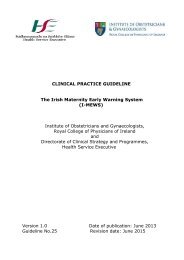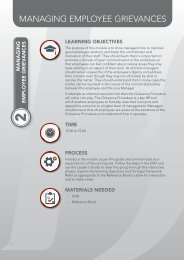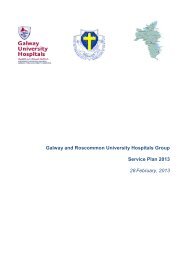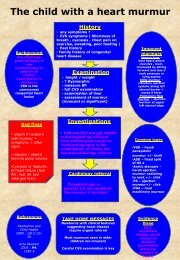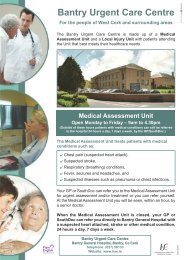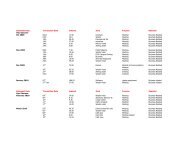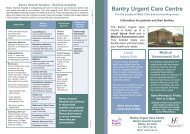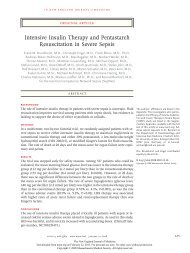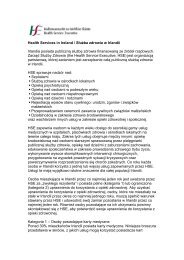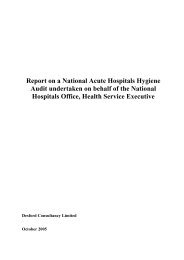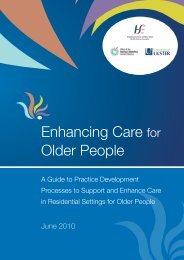Review of acute hospital services in the Mid - Health Service Executive
Review of acute hospital services in the Mid - Health Service Executive
Review of acute hospital services in the Mid - Health Service Executive
- TAGS
- acute
- www.hse.ie
Create successful ePaper yourself
Turn your PDF publications into a flip-book with our unique Google optimized e-Paper software.
<strong>Review</strong> <strong>of</strong> <strong>acute</strong> <strong>hospital</strong> <strong>services</strong> <strong>in</strong> HSE <strong>Mid</strong>-West<br />
An action plan for <strong>acute</strong> and community <strong>services</strong><br />
Planned care will be streamed separately from unscheduled care. This reduces<br />
cancellations, achieves a systematic and predictable workflow, and improves <strong>the</strong> quality <strong>of</strong><br />
service to patients. However, patient safety needs to be at <strong>the</strong> forefront <strong>of</strong> any proposal that<br />
<strong>in</strong>volves elective care be<strong>in</strong>g delivered at a distance from critical care. An analysis undertaken<br />
by <strong>the</strong> Department <strong>of</strong> <strong>Health</strong> <strong>in</strong> <strong>the</strong> UK, identified that 98 per cent <strong>of</strong> elective care by volume<br />
requires a critical care stay <strong>in</strong> fewer than 1 per cent <strong>of</strong> cases 93 . Therefore, <strong>the</strong>re is an<br />
argument that regional centre <strong>in</strong>patient based <strong>services</strong> can be separated <strong>in</strong>to those which<br />
are critical care dependent and those which are not, and both need not necessarily need to<br />
be located on <strong>the</strong> same site.<br />
The European Work<strong>in</strong>g Time Directive is dictat<strong>in</strong>g <strong>the</strong> m<strong>in</strong>imum number <strong>of</strong> consultants <strong>in</strong> a<br />
team needed to deliver a cont<strong>in</strong>uous 24/7 commitment that complies with <strong>the</strong> regulations,<br />
and <strong>the</strong> m<strong>in</strong>imum workload required to justify a team <strong>of</strong> that size be<strong>in</strong>g grouped toge<strong>the</strong>r <strong>in</strong><br />
that manner.<br />
Therefore, <strong>the</strong> <strong>acute</strong> teams <strong>in</strong> <strong>the</strong> regional centres <strong>of</strong> <strong>the</strong> future, for A&E, medic<strong>in</strong>e, surgery,<br />
trauma, etc., will be based upon this consultant pr<strong>of</strong>ile <strong>of</strong> 8 or more <strong>in</strong> <strong>the</strong> specialty group<strong>in</strong>g.<br />
The critical mass argument will be considered next when we come to consider regional<br />
centres and <strong>the</strong> evidence surround<strong>in</strong>g what size <strong>of</strong> catchment population <strong>the</strong>y need <strong>in</strong> order<br />
to deliver best <strong>acute</strong> healthcare.<br />
In turn, <strong>the</strong> regional centre may provide, or be supported by, tertiary, highly specialised<br />
<strong>services</strong>, with <strong>in</strong>dividual <strong>services</strong> <strong>in</strong>clud<strong>in</strong>g neurosurgery, cardiac surgery, transplantation<br />
surgery, plastic surgery and certa<strong>in</strong> children’s <strong>services</strong>.<br />
Catchment populations for <strong>acute</strong> regional <strong>services</strong><br />
Catchment populations provide a proxy for ensur<strong>in</strong>g a sufficient critical mass <strong>of</strong> patient<br />
volumes to provide safe and viable <strong>services</strong> staffed by specialist and sub-specialist<br />
consultants and medical staff work<strong>in</strong>g <strong>in</strong> susta<strong>in</strong>able rotas.<br />
The Royal College <strong>of</strong> Surgeons <strong>in</strong> Ireland has identified that <strong>the</strong> m<strong>in</strong>imum number <strong>of</strong> general<br />
surgeons required with<strong>in</strong> a unit is 12 allow<strong>in</strong>g for sub-specialty <strong>in</strong>terests and suitable rota<br />
cover. Assum<strong>in</strong>g a ratio <strong>of</strong> 1 general surgeon per 25,000 <strong>of</strong> <strong>the</strong> population, this derives a<br />
catchment population <strong>of</strong> 300,000 for a regional centre 94 . A review <strong>of</strong> medical staff<strong>in</strong>g<br />
workforce undertaken by a national task force <strong>in</strong> Ireland modelled consultant numbers on a<br />
catchment population <strong>of</strong> between 350,000 and 500,000 95 .<br />
93 Build<strong>in</strong>g a <strong>Health</strong> <strong>Service</strong> Fit for <strong>the</strong> Future, A National Framework for <strong>Service</strong> Change <strong>in</strong> <strong>the</strong> NHS <strong>in</strong> Scotland, 2005.<br />
94 The Future <strong>of</strong> Surgical Specialties <strong>in</strong> Ireland, Royal College <strong>of</strong> Surgeons <strong>in</strong> Ireland, April 2004.<br />
95 Report <strong>of</strong> <strong>the</strong> National Task Force on Medical Staff<strong>in</strong>g, June 2003.<br />
117



